Abstract
The Indian lunar mission Chandrayaan-1 will have a mass of 523 kg in a 100 km circular polar orbit around the Moon. The main factors that dictate the design of the Indian Moon mission are to use the present capability of launch vehicles and to achieve the scientific objectives in the minimum development time and cost. The detailed mission planning involves trade-off studies in payload optimization and the transfer trajectory determination that accomplishes these requirements. Recent studies indicate that for an optimal use of the existing launch vehicle and space-craft systems, highly elliptical inclined orbits are preferable. This indeed is true for the Indian Moon mission Chandrayaan-1. The proposed launch scenario of the Indian Moon mission program and capabilities of this mission are described in this paper, highlighting the design challenges and innovations. Further, to reach the target accurately, appropriate initial transfer trajectory characteristics must be chosen. A numerical search for the initial conditions combined with numerical integration produces the near accurate solution for this problem. The design of such transfer trajectories is discussed in this paper.
Similar content being viewed by others
References
Biesbroek R and Janin G 2000 Ways to the Moon?,ESA Bulletin 103 92–99.
Adimurthy V 2003 Moon Mission Programme — Objectives and Challenges, Advances in Applied Aerodynamics and Design of Aerospace Vehicles; In: Proceedings ofSAROD- (eds) Biju Uthupet al (New Delhi: Tata McGraw-Hill Publishers) pp. 1–9.
Ramakrishnan S, Somanath S and Balakrishnan S S 2003 Multi-orbit Mission by PSLV-C3 and Future Launch Opportunities,Space Technology 23(2–3) 197–205.
Battin R H 1987 Introduction to Mathematical Meth- ods of Astrodynamics;AIAA Education Series, AIAA, New York.
Brown Charles D 1992 Spacecraft Mission Design;AIAA Education Series, AIAA, Washington DC.
Ramanan R V 2002 Integrated Algorithm for Lunar Trans- fer Trajectories Using a Pseudostate Technique;J. Guid- ance, Control and Dynamics 25 946–952.
Ramanan R V and Adimurthy V 2005 Non Impact Lunar Transfer Trajectories Using Pseudostate Tech- nique;J. Guidance, Control and Dynamics 28 221–229.
Adimurthy V, Selent B, Rudolph S and Weigand B 2002 Qualitative and quantitative investigation of the parame- ters of genetic algorithms for optimum cooling of bodies by internal convection;Proceedings of the 5th World Congress on Computational Mechanics (WCCM V), ISBN 3-9501554-0-6, Vienna University of Technology, Vienna, Austria.
Ramanan R V and Adimurthy V 2005 Precise lunar gravity assist transfers to Geo-stationary Orbits;J. Guidance,Control and Dynamics (accepted).
Author information
Authors and Affiliations
Rights and permissions
About this article
Cite this article
Adimurthy, V., Ramanan, R.V., Tandon, S.R. et al. Launch strategy for Indian lunar mission and precision injection to the Moon using genetic algorithm. J Earth Syst Sci 114, 711–716 (2005). https://doi.org/10.1007/BF02715954
Issue Date:
DOI: https://doi.org/10.1007/BF02715954




